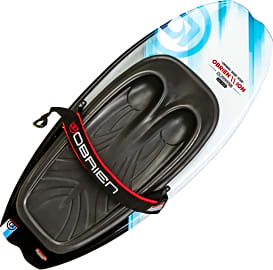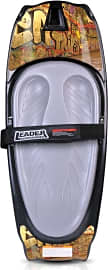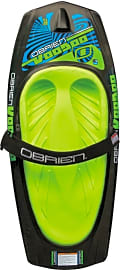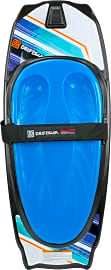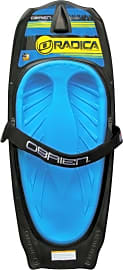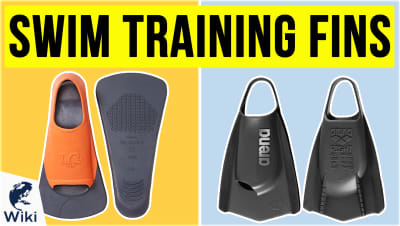The 9 Best Kneeboards

This wiki has been updated 43 times since it was first published in August of 2015. Whether you're a beginner or an advanced stunt performer, one of the kneeboards in our carefully curated list will help you enjoy your time out on the water. We've made sure to include models designed for comfort and ease of use, most of which are suitable for riders of all skill levels. They come in a range of colors, too, making it possible to express your personal style while having fun. When users buy our independently chosen editorial picks, we may earn commissions to help fund the Wiki.
Editor's Notes
May 01, 2019:
Kneeboards are designed to be towed behind a boat, just as you would an inflatable tube. Though there aren't too many major differences between models, you can look out for several features as you shop to find the best option for your needs. Details you'll want to review include the presence or absence of knee straps, tail shape, and, of course, the board's appearance. There are tons of different colors and patterns to choose from, which should please style-oriented teenagers.
In terms of updates, the O'Brien Ion has been replaced with a redesigned version that goes by the same name, and the Driftsun Crush was added to the list because of its popularity with riders of various skill levels.
History Of Kneeboarding
Hydroslide is still in business manufacturing top-quality kneeboards today.
Unlike modern day surfing, which has its origins in the late 1700s, kneeboarding can be considered a newcomer to the sporting world. The first commercially produced kneeboards weren't available until the 1950s. These first models were designed for wave riding, as opposed to towing behind a speed boat as is often associated with the sport today.
Over time as water skiing gained in popularity, riders started to experiment with different riding positions, which led to the birth of the water ski kneeboard in 1972. It was co-invented by Bud Holst and Mike Murphy, who named it the Knee Ski. Hulst was a surfer who manufactured wave riding kneeboards under the name El Paipo, which was a tribute to the original paipo boards the Polynesians had been riding for centuries. Murphy was a professional show skier.
Similar to a boat hull, the original Knee Ski was manufactured from molded fiberglass, giving it a neutral buoyancy. A neoprene pad was used to cover the deck and provide cushioning for the rider. There was also a Velcro strap designed to go over the knee and keep the rider firmly on the board.
In 1973, just one year after the commercial release of the Knee Ski, a former employee named John Taylor decided to leave the company and produce his own boards under the name Glide Slide. Instead of copying the fiberglass construction of the Knee Ski, he tried a new approach and manufactured his boards out of a plastic shell with a foam filling. The Glide Slide was molded into a tear drop shape, which unfortunately produced an unstable ride. The unstable ride coupled with the 1973 oil crisis' affect on the water sports industry spelled disaster for the Glide Slide and the company soon faltered.
In what could be considered karmic justice, a former employee of Glide Slide named Danny Churchill, bought the failing company and turned it around. He redesigned the Glide Slide, making it more stable, and renamed it the Hydroslide in 1976. Under his leadership, the company prospered and is credited with popularizing the sport over the following decade. Hydroslide is still in business manufacturing top-quality kneeboards today.
Professional Kneeboarding
Competition kneeboarding started to develop in the early 1980s when Rolan Hillier, a Masters Overall Water Ski and National Slalom and Trick Champion, formed the International Kneeboard Association (IKA). He created rules and regulations for both boat towing and cableway towing kneeboarding. For boat towing, he created three competition events, wake crossing, slalom, and trick. There was also a special event called the Flip-off, in which a rider tried to complete as many flips as possible in twenty seconds. This actually proved to be one of the most popular events with spectators. For cableway towing, Hillier only created the trick event and included the use of ramps for flips and spins. This is due to the fact that cableway towing does not create wake for competitors to utilize when performing tricks as boat towing does.
He then went on to broadcast the National Kneeboarding Championship on ABC and PBS, which was the very first broadcast of its kind.
In addition to founding the first competitive kneeboarding association, Hillier also wrote and published the first kneeboarding book, entitled "Kneeboarding A - Z". He then went on to broadcast the National Kneeboarding Championship on ABC and PBS, which was the very first broadcast of its kind. The following year, in 1973, Orlando's Sea World approched Hillier to hold the National Championships at their park, but under one condition, the IKA's original sponsors could not participate. Hillier declined the invitation as he felt strongly that the IKA's original supporters should be included.
Hillier's refusal to Sea World paved the way for the creation of the American Kneeboarding Association by a group of water skiers from the lower Midwest region. They came together to charter its founding in 1973 and produced trick and slalom events modeled after the USA Water Ski events of the same names. They tried including two other events, wake crossing and turns, but these did not catch on at the pro level and have since become novice only events.
Recreational Versus Competitive Kneeboards
Recreational boards and competitive boards are designed with different riders in mind and are manufactured to different specifications. The average recreational board is roto-molded, which is a readily available and low cost manufacturing method. They also have soft, wide edges to offer beginner riders more control and easier turning. A recreational board is generally thick and extremely buoyant. This allows them to double as a flotation device for riders who fallen off. Depending on the type of recreational board you purchase, it may or may not have bottom fins to aid in turning.
Competitive kneeboards are more expensive as they are compression-molded, making them more durable and better suited to the high speed runs of professional riders. They will also be thin and lightweight with sharp edges designed for tight cornering and radical tricks. Since they are thinner, they are less buoyant than recreational boards. This allows high level riders to dig deeper into the water for better starts and trick launches.
Both recreational and competitive boards can be found in slalom and trick board styles. A trick board will have a rounded bottom and edges. Slalom boards need to be capable of tighter turns and have sharper edges allowing them to cut deeper into the water and hold better around curves.




